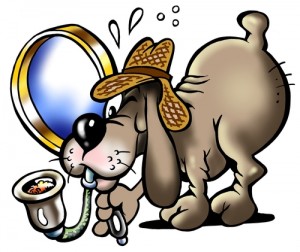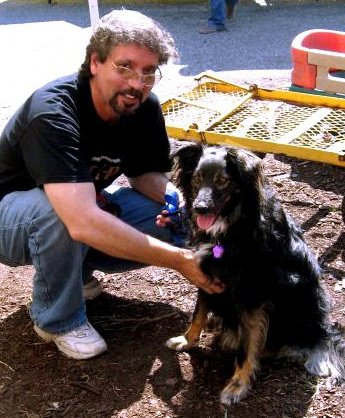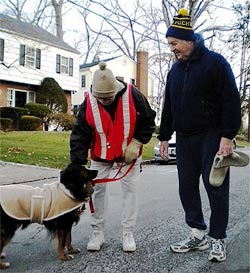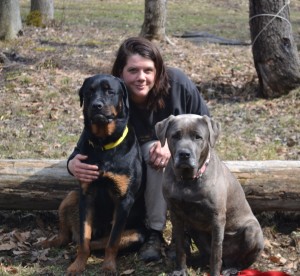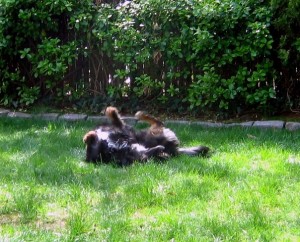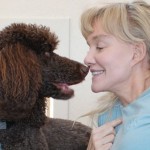Try this at home. Google “dog people aggression.”
I did and here’s what I found. Outside of two notable exceptions, Google’s top eleven picks didn’t offer much that was helpful. Most sites referred to so-called “dominance aggression.” One site delineated a tedious taxonomy of differently motivated types of dog aggression. Several sites recommended shock collars and other aversives to “correct” the dog when she or he behaved aggressively. Great. One site shilled for the Dog Whisperer. Upon clicking on another I was warned “do not enter–site might contain malware.”
So much for that excellent “expotition.”
Welcome back John!
In the fifth post in our six-part series: Difficult, Aggressive Dogs Need Strong Training. (Really?), John Visconti recounts his success and ongoing efforts to help Pepper change her emotional reaction to strangers, and build skills so that she has options other barking, lunging, and air snapping when she encounters people she doesn’t know.
Hopefully, the next time someone searches for sound information about how to help their people-aggressive dog, John’s and Pepper’s story will land near the top of Google’s offerings. I’m concerned that people typically don’t look beyond the first page of url’s that Google coughs up. And, if unsuspecting dog owners find what I did, they might conclude that aversively punishing their barking and lunging dog is the way to go. Noooooooo!
(NOTE: I know many of you reading this have posted great articles about how to use classical conditioning and positive reinforcement to help aggressive dogs that didn’t show up in Google’s top 10 for my search. Just a friendly reminder for you (and me): Search engine optimization.)
Part 5: LUNGING AND BARKING AT PEOPLE? NOT FOR LONG!
Within a few weeks of Pepper being home with me I began to invite visitors to my home. (I didn’t want to rush the process). They were instructed to call me when they were a block away.
At that point, I would leash Pepper and move to the front lawn with her. I knew very early on that people entering “her” space was a major trigger for reactive outbursts, so when they arrived, our visitors were instructed to completely ignore Pepper and me. They were NOT to look at her while she lunged, snarled, barked, growled, and to enter the house. This was not an easy thing for my friends to do with a dog behaving like a Godzilla on a bad day.
While she was reacting, I was dropping treats on the ground. Eventually, this progressed to my offering her treats from my open hand, then between my fingers, then with open hand and an “off” and “take it” cue. I was always raising the criteria. My thought process was that I wanted to keep her reactivity as much in check as possible by forcing her to focus on the food in my hand which in turn, took her focus away from what was setting her off. While doing so, I remained unconcerned about how she was behaving.
Once my guests were inside, again, they were instructed to ignore us. Pepper and I would sit at the far end of the living room and each time a guest appeared in the room, she would receive a food reward. This was the desensitization part of the process.
This fairly quickly morphed into her receiving positive reinforcement for looking at someone. When she did, she was “clicked” and rewarded. This was the counter conditioning part of the process.
Today, Pepper is still reactive to people coming to the front door. We are working on this. Boy are we working on this.
Once inside my home, or if she has met the person before, she’s great. But the initial approach at the front door is still a problem. Might always be. But we’re going to continue to work on this for her good and mine.
Pepper’s Reactivity to Strangers
Another pressing behavioral issue that needed to be resolved was Pepper’s reactivity to strangers, particularly on walks. I was always able to stay one step ahead of her, and buffer the space between her and the stranger by getting in between them, even if the stranger was on other side of the street. But this was no way to live. Management of the problem (changing sides of the street, etc) needed to give way to a new response.
Fortunately, as if sent from dog heaven, an elderly gentleman arrived on the scene during one of our morning walks. He spotted us, and made a direct line, right across the street to us. To no avail, I explained, from a distance, that he needed to stop his approach. He simply kept coming forward while Pepper went ballistic. At some point, better sense kicked in and the gentleman stopped his approach.
Nearly every morning, we’d see him and the entire episode would repeat itself like a bad version of Groundhog Day.
Finally, he heeded my advice and stood in place. I handed him treats and explained that he should drop them about a few feet from his feet. As Pepper approached, he reached out to give her the treats and she performed a rather impressive air bite. While well out of his distance, she had made her point.
He then learned how to approach and toss treats from a distance. Pepper learned, through much repetition: “Oh goodie, strangers, I get treats.” We worked slowly, in small increments.After a few more meetings, both man and dog embraced the routine.
Long story short, in my article on LI Dog Directory you’ll see a picture of Pepper and her nemesis standing together. He’s holding her leash and petting her chest. She was happy as could be.
The footnote to the story is that the day after the picture was taken, the gentleman was bitten by a strange dog on a walk with his owner because he approached, hand extended to greet the dog.
Evidently, Pepper had learned the greeting routine better than her friend.
Today, Pepper is fine with greetings. At times, she’s a bit wary and perhaps will always be. There are no magical fixes. But I no longer have any concerns about her interactions with strangers and I always give her plenty of room to retreat if she’s not comfortable. She, as well as every other dog, deserves that.
My proudest moment with Pepper was yet to come–helping her ride out thunderstorms.
Part 6 of John’s and Pepper’s story will be posted on Wednesday, April 13, 2011.
See you then!
——————————————
Previous posts in this series:
Part 1: Difficult, Aggressive Dogs Need “Strong” Training. Really? (John’s story: John Meets Pepper)
Part 3: Difficult, Aggressive Dogs Need “Strong” Training. Really? (John’s story: Positive Does NOT Mean Permissive)
Part 4: Difficult, Aggressive Dogs Need “Strong” Training. Really? (John’s story: Resource Guarding? Biting? Dog-dog Aggression? No Sweat.)
Subsequent post in this series:
Part 6: Difficult, Aggressive Dogs Need “Strong” Training. Really? (John’s story: Scrunchies and Lavender Candles for Thunder Phobia? Yep?)
Tags: Air biting, Aversive dog training, Aversives, Aversives in dog training, Barking and lunging, Classical conditioning, Dog aggressive to people, John and Pepper, John Visconti, People-aggressive dog, Positive reinforcement
